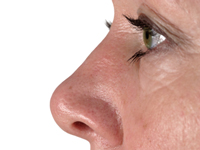Disclosure: In any review for a product or service, products or compensation may have been provided to me to help facilitate my review. All opinions are my own and honest. I am disclosing this in accordance with FTC Guidelines. Please see “Disclose” and "Terms of Use" tabs for more information.
Most people know how to treat a sunburn. You can soothe the affected area with cool compresses and slather on aloe vera to hydrate, alleviate pain, and help the healing process. Some ibuprofen couldn’t hurt, either, if you have a particularly painful sunburn. However, the effects of this UV damage aren’t over when your sunburn goes away. Severe sunburns and even frequent tanning can lead to sun damage that causes your skin to wrinkle and sag prematurely. This process is called photoaging and it can make you look a lot older than you actually are (just look at “Tanning Mom” Patricia Krentcil, who at 45 looks closer to 65 thanks to years of treatments at tanning salons). Luckily, there are a slew of products on the market aimed at reversing the signs of aging, and sun damage in particular. Here are just a few treatment tips that should help you get your skin looking young and fresh in short order, even if you’ve flirted with the sun for years.
- Wear sunblock. The best defense is a good offense, and further sun damage will only exacerbate your problem. So it’s important to start wearing a broad spectrum UVA/UVB sunblock with a high SPF now to ensure that no further harm is done to your skin. Wear a broad-spectrum sunblock that is also environmentally friendly. There are sunscreens that contain reef-safe zinc oxide ingredients that protect you from getting sunburned. Since it’s practically impossible to stay covered all the time (and who would want to?) this is a good way to keep the sun’s harmful rays from further aging your skin. You put it on your kids, so why wouldn’t you use it yourself? These days it’s not hard to find multi-use products that offer an SPF along with cosmetic coverage, acne treatment, moisturizer, or any number of other benefits, making this a great way to protect and treat your skin at the same time.
- Retin-A. With years of testing, clinical trials, and consumer reports to recommend it, Retin-A is one product that has been proven effective when it comes to fighting the signs of aging. While you can certainly use OTC creams containing retinol, these products don’t tend to have the heavy-hitting power of their more potent, prescription counterpart. Although it was originally intended as a means of treating acne, it also provides the bonus of fading dark spots, evening skin tone, and fighting wrinkles, all of which may be related to sun damage.
- Skin resurfacing. Both dermabrasions and chemical peels are intensive treatments that have the power to restore your skin to a more youthful state. Unfortunately, they can be rather pricy procedures, and you’ll have some down time for recovery that could last several days, during which your skin will peel as though it has been burned. This is a byproduct of removing the top layers of skin. The result, however, is skin that looks fresh and rejuvenated (following healing). You’ll see a noticeable reduction in scars, pigmentation, and other damage.
- Fillers. Wrinkles are among the most common type of sun damage, and neither topical nor skin-removal treatments can totally reverse them. Fillers like Juvaderm and Restylane that contain hyaluronic acid, on the other hand, can volumize the skin in order to fill in even deep wrinkles. If this type of sun damage has occurred, this is just one option that could deliver spectacular results.
- ILP therapy. You might not be keen on lasers, which is why you’ve turned to reviews on Epilator Central rather than using laser hair removal to get rid of the peach fuzz on your upper lip. But Intensive Light Pulse therapy is a little different from the laser resurfacing treatments commonly used to combat sun damage. For one thing, this method does not remove your top layers of skin, unlike other methods, making it less invasive. And although redness and swelling can occur, and it can take several days to heal, you won’t have to deal with the massive peeling that other laser treatments cause.

















Speak Your Mind
You must be logged in to post a comment.